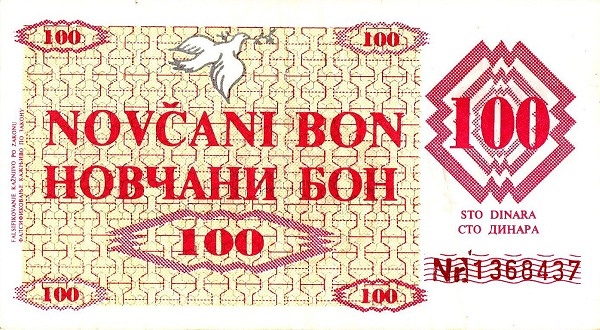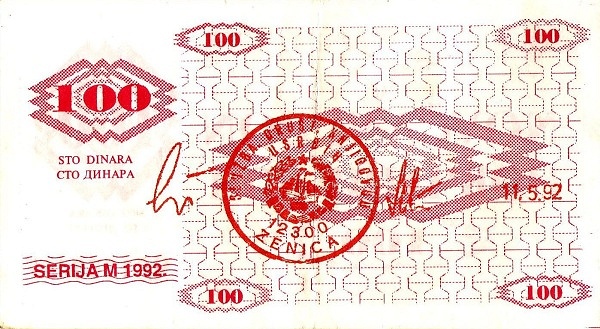History of and Key Counterfeit Identifiers for Local Provisional Novčani Bon Notes

The earliest banknotes of Bosnia and Herzegovina were produced during a time of war, civil and political unrest, and chaos. As such, these early banknotes have a complicated history filled with official and unofficial issues, emergency vouchers/coupons, and regional overstamping. Furthermore, due to the chaos of the war, typical security features are absent from these banknotes, meaning that counterfeits are abundant in the market today (most of which appear to be modern forgeries intended to capture profits from the collecting markets). Commonly counterfeited banknotes are the P-1 and P-2 notes - the first banknotes of the newly formed Republic of Bosnia and Herzegovina which were actually just Yugoslavian notes from 1990 which have been overstamped with the seal of the National Bank of Bosnia and Herzegovina. Counterfeiters often purchase genuine copies of the underlying Yugoslavian note for cheap and apply a forged stamp/seal to artificially increase the value of the note. Further discussion of these notes and advice on how to spot counterfeit copies are given in the previously published article "ON BOSNIA AND HERZEGOVINA P-1 AND P-2 NOTES" by akaardvark387
However, there are many more counterfeit notes from this period of Bosnia and Herzegovinas history which have flooded the collectors market as of late, permeating into many reputable dealers' inventories. Of particular interest to this article are the local provisional Novčani Bon (banknote voucher) notes issued in 1992 of denominations 100, 500, 1000, and 5000 dinars (P-6, P-7, P-8 and P-9). Figure 1a/b shows an example of a genuine 100 dinar note (P-6), courtesy of the Banknote Museum [Ref. 2]. As the war progressed, two immediate problems arose: the supply of overstamped Yugoslavian notes was dropping, and the war had isolated multiple districts and prevented them from receiving shipments of these emergency banknotes. These towns - Zenica, Visoko, Fojnica, Kresevo, Tesanj, and Breza - had decided to print their own banknote vouchers to combat these problems. These notes were all printed in Zenica and stamped on the back by the Post of Social Accountancy of Zenica. These notes have a wide range of variants which include different serial number prefixes (No. vs Nr.), different serial number lengths (six vs seven), and different stamp sizes from some regions [Ref. 3].


A quick search on eBay and various dealer sites will return many listings for these notes, most of which appear to be modern forgeries intended to deceive the collecting audience. The remainder of this article is devoted to presenting quick and easy methods of determining the authenticity of such notes which are based on discussions, articles, and other resources gathered from Bosnian numismatic groups [Ref. 2, 3, 4].
The most commonly reported identifier (even appearing in the Banknote Museum gallery) is the shape of the accent above the Č in the text "NOVČANI BON" on the obverse of the note (see Figure 2 - genuine on left, counterfeit on right). Counterfeit notes have a much deeper accent when compared to the original notes. This alone is typically sufficient to detect whether a note in question is genuine or not.
For completeness, other counterfeiting identifiers which have been noted in the past are also reported here. Another quick giveaway can be gleaned by examination of the dove and twig at the top of the obverse of these notes (Figure 3 - genuine on left, counterfeit on right). The dove in the counterfeit notes are made with a raster, so examination through a magnifying glass reveals small dots which do not appear in genuine samples. Additionally, the twig on the left side of the dove should come out of its beak in the genuine notes - the counterfeit ones often appear to be missing this detail.
Next, there is a typo in the Cyrillic text on the lower left side of the obverse. The forged notes had erroneously replaced the Њ in ФАЛСИФИКОВАЊЕ КАЖЊИВО ПО ЗАКОНУ with HJ to give ФАЛСИФИКОВАНJЕ КАЖНJИВО ПО ЗАКОНУ. Refer to Figure 4 for more clarity (genuine on left, counterfeit on right).
Lastly, on the reverse, a quick indicator of the authenticity of the note can be found in the text "SERIJA M 1992" on the lower left, specifically, in the font used for the letter R in SERIJA. Figure 5 shows the differing appearance between the genuine and counterfeit notes (genuine on left, counterfeit on right).





